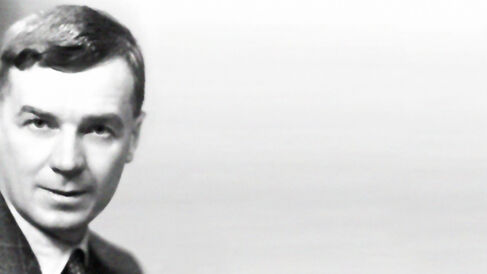Richard Laurence Millington Synge

Nobel Prize in Chemistry 1952 for the invention of partition chromatography, shared with Archer John Porter Martin.
Department of Biochemistry Part II student (1935-1936) and PhD student (1936-1939, PhD awarded 1941).
Richard "Dick" Synge went to Winchester School and won an exhibition in Classics to Trinity College, Cambridge. However, he had read in the newspapers of Frederick Gowland Hopkins' view that it must be possible to reduce the complexity of the cell to its component parts and this seems to have been influential in inducing Synge to switch to science. He went up to Cambridge in 1933 where, remarkably, one of his first encounters was with Fritz Haber, the Nobel Prize-winning chemist who invented the Haber–Bosch process but is perhaps best known as the 'Father of Chemical Warfare' for his work developing poisonous gases during World War I. Haber worked for a few months in Cambridge in 1933.
Synge took Chemistry, Physics and Physiology in Part I, and whilst taking Part II Biochemistry decided that he would work on proteins. He became a research student in the Department under the supervision of Norman "Bill" Pirie, who, in 1936 with Frederick Bawden, John Desmond Bernal and Isidor Fankuchen, had shown that a virus can be crystallized and obtained X-ray patterns of tobacco mosaic virus. Synge, however, had begun to think about possible methods by which small molecules, including those derived from the partial breakdown of proteins, might be separated and identified.
During this period Synge worked alongside Hedley Marston, the Australian physiologist who was a guest worker in the Department and who was also an adviser to the International Wool Secretariat. The upshot was a studentship for Synge to study the amino acid composition of wool that he took with him when, after obtaining his PhD, he moved to the Wool Industries Research Association in Leeds, now the British Textile Technology Group.
In 1938 Synge met Archer John Porter Martin who had also been an undergraduate at Cambridge before working in the Physical Chemistry Laboratory and then the Dunn Nutritional Laboratory where he developed a liquid-liquid countercurrent system for concentrating vitamin E. In 1938 Martin also moved to the Wool Industries Research Institution. Together they devised a method of using columns of silica with water to form a stationary phase whilst a second, non-miscible liquid, flowed down the column. For the second liquid they used chloroform and by this means separated acetamino acids from protein hydrolysates, the components of the mixture being distributed between the two phases depending on their relative affinity for each of them. This new technique became known as partition chromatography. They went on to develop gas-liquid chromatography. These methods revolutionized analytical chemistry and Martin and Synge shared the 1952 Nobel Prize in Chemistry.
In 1943 Synge moved to the Lister Institute in London where he analysed the amino acid composition of gramicidin, work later used by Frederick Sanger in determining the structure of insulin. Synge prepared crystals of gramicidin S for his friend Dorothy Hodgkin to examine by X-ray crystallography in Oxford. Hodgkin involved a fourth year chemistry student in the project. Her name was Margaret Roberts, who later became well known as Margaret Thatcher and who was referred to by Synge as his first student. In 1948 Synge moved to the Rowett Research Institute in Norwich, continuing studies of the reactions of quinones with proteins and amino acids in plants.
Like many scientists then and now Synge was politically very aware and in fact before the war he became a member of the Communist Party. He worked actively for peace all his life and was a signatory of the 1982 Pugwash Declaration on the dangers of nuclear war. Synge had a view of politicians perhaps shared by many scientists, which was amusingly illustrated by the Labour MP Tam Dalyell's account of Synge's appearance at the Labour Party's Two Way Traffic in Ideas conference in the autumn of 1963. This was hosted by Richard Crossman, Harold Wilson's Shadow Secretary for Education and Science. "Suitably gratified, Crossman effusively observed that he was delighted to see a Nobel Prize-winner taking such an interest in the 'white heat of the technological revolution'. One Dick [Crossman] to another [Synge]: 'Dick, why did you come?', 'Well, it's like this, Mr Crossman,' drawled this tall, lean, twinkling bow-tied figure. 'I, as a Wykehamist, know better than most the propensity of other clever Wykehamists like you, Mr Crossman, to meddle in affairs which they do not fully understand - and I am here to observe exactly what you Labour Party people are up to - I don't want you to put people like me in a research straightjacket, supposing that you can direct our research to what you deem useful ends when you can do no such thing.'"
After retirement Synge moved to Aberdeen where he died peacefully on August 18th 1994.
